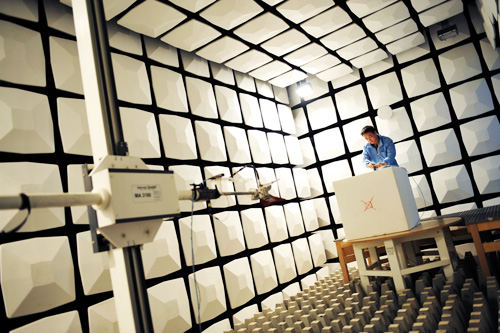|
 |
|
A TECHNOLOGY GIANT: A researcher tests equipment in the laboratory of Huawei Technologies Co. Ltd. Every year, the company invests at least 10 percent of its revenue in research and development (LIANG XU) |
Situated in Shenzhen, Guangdong Province, the Shenzhen Institute of Advanced Integration Technology aspires to spearhead science and technology innovation and the application of new technologies.
On July 7, it launched a project to apply cloud computing technology to the machine tool industry, the first of its kind in the country. The technology, jointly developed by the institute and ACL Machinery Group in China, was adopted by U.S. National Aeronautics and Space Administration (NASA), General Motors and Chinese company Huawei Technologies Co. Ltd.
Founded in 2006 under the Chinese Academy of Sciences, it is the only state-owned research institute in Shenzhen. Currently, the institute employs more than 1,600 researchers. So far, it has successfully spawned 60 companies in new technologies such as cloud computing, the Internet of Things, alternative energies and new materials.
"Since its inception, the institute has been committed to institutional innovation, conducting basic and applied research, and commercializing more research results," said Pan Jianping, a researcher and president of the institute.
Pan said that to convert science and technology into productivity, they must closely wed science and technology with production.
The institute is deemed as a successful example in commercializing science and technology.
Policy-directed innovation
One day before the institute launched its cloud computing technology application project, a national science and technology innovation conference was convened in Beijing. The two-day meeting saw the passage of the Opinions on Deepening China's Scientific and Technological System Reform, Accelerating the Building of National Innovation System, with guidelines for a new round of reform.
A conference on scientific and technological innovation at such a high level and of such a grand scale is unprecedented.
While attending the conference, President Hu Jintao urged China to enhance scientific and technological innovation capacity, and to integrate science and technology with social and economic development.
The president proposed suggestions for accelerating the construction of an innovative country, such as promoting innovation-driven development, improving indigenous innovation capacity and a system for cultivating talented people, deepening reform of scientific and technological systems, optimizing the environment for innovation, and expanding international cooperation.
Innovation became a buzzword in China several years ago. In June 2004, at a Central Economic Work Conference, President Hu said that scientific and technological innovation capacity is a decisive factor for a country's development, and the core of a country's competitiveness. In the last week of that year, he mentioned the word "indigenous innovation" on three occasions related to science and technology.
At the end of 2005, China published the Guidelines on National Medium- and Long-Term Programs for Science and Technology Development (2006-20). The meticulously drafted document said that the goal of deepening scientific and technological system reform is to push forward and improve the construction of a national innovation system.
At the beginning of 2006, at the National Science and Technology Conference, the Central Committee of the Communist Party of China and the State Council published the decision on implementing the guidelines and enhancing the country's indigenous innovation capacity.
After GDP growth soared near 10 percent for 30 years, foreign media hailed the country's move to focus more on the composition and quality of GDP in addition to its growth rate.
| 